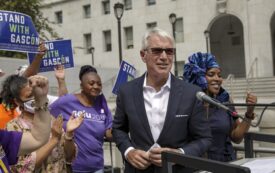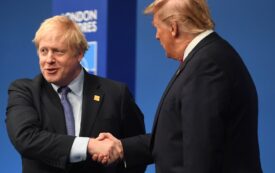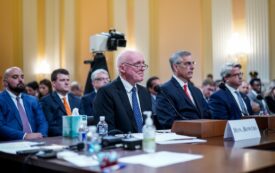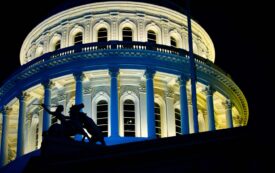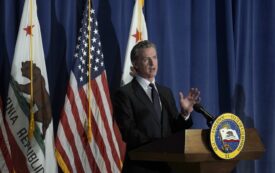Wyoming Rep. Liz Cheney’s overwhelming primary loss on Tuesday to Trump-endorsed Harriet Hageman makes it clear (in case there was any remaining doubt) just how cultist the debased modern-day Republican Party is.
Last week, Donald Trump’s home was raided by FBI agents armed with a warrant indicating there was probable cause that the Espionage Act had been violated. Last month, the networks broadcast the most recent January 6 House hearings, which showed the extent to which Trump and his acolytes marshaled the mob in an attempt to obstruct the peaceful transfer of power. Yet after all of this, Trump remains wildly popular among GOP voters, and Trump’s most vocal critic from within the GOP received less than one-third of the votes cast in the Republican primary in Wyoming. She was ousted by a candidate whose previous career highs as an attorney involved attacking any and all environmental regulations, and who, on the stump, urged voters to dump Cheney because, in joining the House committee investigating January 6, she “betrayed Wyoming, betrayed the country and she betrayed me.”
Trump responded gloatingly to Cheney’s primary defeat, framing it explicitly as payback for her role on the January 6 committee. On his Truth Social site, he declared Cheney a “fool,” and opined that she “should be ashamed of herself.” Trump’s post attacked the “Unselect Committee” as being made up of “political Hacks and Thugs,” and welcomed Cheney’s descent into “political oblivion.”
Apart from the puerile nature of the post, it’s the venom that stands out. In race after race around the country this election season, Trump has attempted — and with some notable exceptions, such as in Georgia — largely succeeding in purging the GOP of any and every independent voice capable of standing up to his authoritarian hold over the party’s rank and file. Eight of the ten Republican Congress members who voted for his impeachment will now be out of office come January. Outgoing Arizona House Speaker Rusty Bowers, who was running for a state Senate seat, and who angered Trump World by testifying before the January 6 committee, lost his primary. “Stop the steal” candidates are now positioned as GOP candidates to run for secretary of state in four of the five swing states of 2020 — Georgia, again, being an outlier here. Trump-backed Senate candidates rode high in primaries in Ohio, Pennsylvania, Arizona, and many other states. And so on.
Despite Trump’s growing legal woes and the escalating risk he now faces of felony charges and conviction, large numbers of GOP political candidates continue to leap to his defense and to attack his opponents within the GOP as being RINOs — Republicans In Name Only. They are, in their embrace of ever more extreme language, buying popularity by espousing a particularly dangerous and anti-democratic stew of lies, rumors and conspiracy theories.
Just this week, for example, New York congressional hopeful Carl Paladino, who not too long ago got into hot water for saying the U.S. needs a political leader capable of moving the crowd like Adolf Hitler did, went on Breitbart Radio to say that Attorney General Merrick Garland “probably should be executed” for authorizing the FBI search of Mar-a-Lago. Florida Sen. Rick Scott compared the FBI raid to the actions of the Gestapo. Rep. Marjorie Taylor Greene called for defunding the entire Department of Justice.
As he flails in the legal realm, Trump, the GOP’s puppet master, is becoming more dangerous by the minute in the political realm. Cheney appears to recognize this, and stated, after her defeat, that she would do everything in her power — including possibly running for president — to thwart the twice-impeached ex-president’s ambitions to return to the White House. If she does so, however, she will undoubtedly run into a buzzsaw of organized GOP opposition, from state GOPs preventing her name from appearing on primary ballots, to decisions by the Republican National Committee to stop her from appearing on the same debate stage as Trump. She has also set up a political action committee, called The Great Task, aimed at educating Americans about the dangers to the democratic system posed by Trump and by his efforts to rewrite history surrounding the events of 2020 and of January 6, 2021.
Now, I’m not a fan — to say the least — of Cheney’s political career prior to her star turn on the January 6 committee. She’s always been fiercely anti-abortion, opposes gun control, was supportive of Trump’s most restrictive anti-immigration policies, and, when he was president, voted in line with his priorities 93 percent of the time. She also strongly supported the waterboarding of terrorism suspects, a ghastly practice approved by her father, Vice President Dick Cheney, and by President George W. Bush, that put a U.S. government stamp of approval on torture.
But in this moment, when a large part of the GOP has overtly embraced paramilitarism, when political candidates run attack ads showing them toting assault rifles and hunting down their less ideologically pure party brethren, and when the GOP’s congressional leadership has come out in support of tactics designed to secure electoral victory even in the face of massive opposition from a majority of the electorate, Cheney’s voice is important.
This past June, she spoke of the “personality cult” gripping the Republican Party. After her primary election defeat this week, she opined about Trump representing a “very grave threat and risk to our Republic” and came as close as any senior politician has done in recent years to calling for the creation of something akin to a popular front, bringing together Republicans of good conscience, Democrats and independents to stop the drift toward authoritarian governance represented by the MAGA movement and its power-hungry leader.
Cheney is absolutely right about the dangers posed by Trump and by Trumpism, even if it took her several long years to reach these conclusions. But I fear her ongoing faith in the ability of the GOP to right itself is entirely misplaced. This is not a story of a good barrel with a few rotten apples. At this point, the entire barrel is corrupted, with only a few good apples left in stock. It’s a bad barrel filled with contamination. Or, to abandon the metaphor, it’s a political party that from top to bottom has, over the past several years, almost entirely remade itself as an extremist tool intended to fluff up one man’s vanity and enable his every assault on the democratic institutions, culture and norms of the Republic. Given that, the idea that its Trumpian mantle can be thrown off seems little more than wishful thinking. And even if it could be, the anti-abortion, anti-immigrant, anti-democratic, pro-torture policies of the pre-Trump GOP should not be idealized either.
